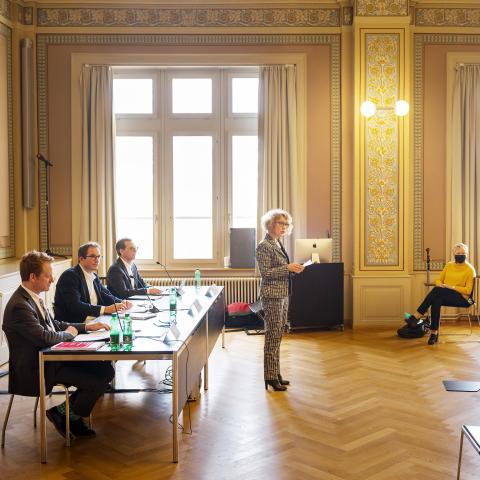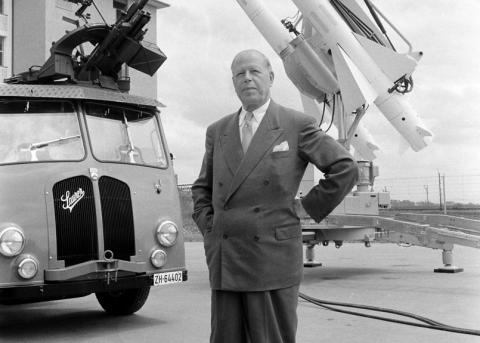Historical dispute: Rectifying Emil G. Bührle’s complex legacy
For the first time, a study draws clear connections between the weapons business and the art collecting of Emil Georg Bührle. Two expert evaluations confirm that there was unacceptable interference in the report. Why the controversy does not harm the reappraisal of the Bührle history.

Any child immediately understands impressionist paintings: you can always look at a picture twice, once from a distance and once up close; first as an overall impression, then as a magnified image of surfaces and points. But it always remains the same picture.
The reappraisal of the history of Emil Georg Bührle (1890–1956), who amassed a fortune by producing weapons for the Nazis and invested it in impressionist masterpieces, can also be viewed according to this logic: from a distance, as a general report, and then in detail, as a dispute over individual words and formulations. The effect is dizzying. Because whether you stand far away or examine the details, the problem with Bührle only gets bigger and bigger.
Controversial findings
This week, the eagerly awaited report of a research project about Bührle was presented in a press conference. The aim of the project was to investigate and review the history of the collection’s origins, just in time for the opening of an extension to the Kunsthaus museum in Zurich. This is where the Bührle Collection will be on display, in a vault-like building designed by star architect David Chipperfield – costing 206 million Swiss francs. Earlier this year, a controversy erupted, involving the director of the research project, Matthieu Leimgruber, a history professor at the University of Zurich, and research fellow, Erich Keller. According to Keller’s criticism, members of the steering committee interfered in the research. Keller did not continue his employment contract.
WOZ newspaper drew attention to his complaints in the article titled, “Bührle History is Whitewashed,” and the University of Zurich commissioned two expert evaluations of the report, which were also published this week (see WOZ no. 34/20 ). But let’s start with the view from a distance.
The research report presented by Matthieu Leimgruber succeeds for the first time in establishing a clear link between Bührle’s arms deals and the development of his art collection. It therefore presents the Bührle history in all its complexity.
Through the Oerlikon WO machine tool factory, which he headed from 1925 and controlled financially from 1938 thanks to capital from his father-in-law, Bührle supported the covert armament of Germany and also supplied other countries with weapons. During the Second World War, Bührle’s fortune swelled thanks to his arms exports to the Nazi regime. After a brief business ethics crisis – Bührle was on the Allies’ blacklists – after the war he fell in line with the anti-Communist defense apparatus of the Cold War. William J. Donovan, head of the OSS (the precursor of the CIA) under President Franklin D. Roosevelt supported him in this regard. Bührle was now able to supply powder rockets to the USA for the Korean War. By 1950, with assets of around 150 million Swiss francs, Bührle was the richest man in Switzerland.
In parallel with his prosperity his art collection grew, encompassing more than 600 paintings and sculptures by the time of his death in 1956. The collection was made possible not only by the proceeds from arms sales, but also because of the deadly Nazi crimes they helped fire. “Bührle profited not only from the opportunities arising from the dissolution and expropriation of Jewish collections, but also from the reorganization of the international art market in the post-war period, which was partly a result of these persecutions,” the study states.
The report also discusses new details on the connection between the collection and the Kunsthaus. “The history of Bührle,” Leimgruber said at the press conference, “has essentially been stored in the cellar of the Kunsthaus since the beginning of the Second World War. Bührle joined the museum’s collection commission as a patron in 1940, and financed the first extension with six million Swiss francs. Bührle found his way into Zurich’s elite through art.
Particularly scandalous in this context is that the president of the Zurich Kunstgesellschaft (Art Society), the banker Franz Meyer-Stünzi, as well as its quaestor, Emil Friedrich, both sympathized with the Nazis. They were among the signers of the so-called Petition of the 200, which demanded that the Swiss Federal Council muzzle anti-Nazi newspapers. When the petition was brought to light in 1946 it caused a scandal. Bührle, who had wisely not signed the petition, defended Meyer-Stünzi. “The unconditional support that Bührle offered the president secured his standing in the Kunstgesellschaft,” the report concludes.
The fact that the Kunsthaus has never made any effort of its own to adequately reassess the complex Bührle history allows for a simple explanation: it has always been part of it. So let’s move on to a closer look, to the controversy about the interference and its evaluation by the two experts.
Apologies and silence
“Freikorps,” “anti-Semitism,” and “forced labor” – members of the steering committee proposed changes to these historical terms appearing in the report; the changes were initially adopted by Leimgruber. The committee was composed of representatives of the city and canton of Zurich, the Kunsthaus, the Kunstgesellschaft, and the Bührle Foundation. The Bührle Foundation director, Lukas Gloor, was particularly active in suggesting edits.
He insisted that the term “Freikorps” be omitted from the report, despite the fact that Bührle was involved with one such extreme right-wing group that hunted down socialist workers after World War I. Nor did Gloor want to see Bührle’s letter of complaint to Nebelspalter magazine referred to as an “antisemitic outburst.” The satirical magazine had caricatured Bührle asleep between moneybags, and Bührle complained about it as a “grotesque Jewish notion.”
The two expert evaluations of the report came to the clear verdict that this interference is not tolerable. “Although the report generally follows best practices of historical contract research, the two interventions do not conform to this,” writes Jakob Tanner, one of the reviewers and Professor Emeritus of History at the University of Zurich. The second reviewer, Esther Tisa Francini, Director of Provenance Research at Museum Rietberg in Zurich, also called on Leimgruber to clearly name antisemitism for what it is – even if the reported incident was the only known example of its kind. Leimgruber did so in the final version of the report.
However, the two experts consider comments by the city’s Cultural Director, Peter Haerle, which questioned Bührle’s profits from Nazi forced labor, to be justified. As such, they did not accept Keller’s accusation that Leimgruber generally adopted academically untenable comments. Nevertheless, this does not alter the fact that there is evidence of interference in the report. Jakob Tanner sharply criticized the organization of the research project, particularly the establishment of a steering committee. “As a rule, the more controversial the issue, the more difficult it is to work with such a body.”
In the case of historical disputes affecting the public interest, a politically composed steering committee means heightened reputational risk: the members of the committee would be under constant suspicion of interfering and the researchers, in turn, of being instrumentalized. The Independent Commission of Experts (ICE) on Switzerland’s involvement in the Second World War, for instance, did not have such a steering committee, despite the pressure to have one. For Tanner, the Bührle case was comparable in terms of its “historical depth.” In his view, “it was a mistake to set up a steering committee.” A similar acknowledgement was also made by Mayor Corine Mauch and Cantonal Councilor Jacqueline Fehr at the press conference.
No self-criticism, however, was practiced by Zurich University. Simon Teuscher, head of the History Department, already defended Leimgruber this summer. The other professors have maintained an eloquent silence. Before the media, Vice President of Faculty Affairs Christian Schwarzenegger presented the evaluations of the report as if the university had done everything right. Despite repeated requests, he did not respond to the criticism of the proven interference and the flawed organization of the research project.
Meanwhile, the university should be grateful to its former research associate, Keller. He raised new questions for investigation with his concept for the report, he drew attention to the problematic steering committee, and he prevented the Bührle Foundation from glossing over the matter. When asked about the outcome, he expressed satisfaction: “I fought back, and with success. Passages that were removed or toned down in response to the interventions were largely restored.”
In general, the controversy has not harmed the reappraisal of the Bührle history. In fact, the present study represents a historical leap forward. Thanks to the expert evaluations, a public discussion can also begin on how to communicate the findings of the report and how the research can now be continued.
Esther Tisa Francini has proposed that the relationships between the Kunsthaus, Kunstgesellschaft, and Bührle Collection now be examined from the Second World War to the present. Jakob Tanner, for his part, has taken up the idea expressed by Keller in his original concept for the report: that the history of provenance research by the Bührle Collection should also be investigated. Which considerations were behind the decision to split the collection into a public and a private part, the latter of which now adorns the premises of the private bank IHAG? Which criteria were followed in clarifying the origin of the paintings, and how did this provenance research contribute to increasing the collection’s value, now estimated at five billion francs? The Bührle archives, which are to be transferred to the Kunsthaus next year, could shed light on this. Erich Keller has already announced that he is going to publish a book on the matter, entitled The Contaminated Museum.
Evasion by the art elite
Ultimately, the conflict has once again shown who has the greatest problem in coming to terms with the Bührle history. As the research report reveals, the Kunsthaus, Kunstgesellschaft, and Bührle Foundation left the steering committee once the accusations became public. Behind closed doors, several participants have said that the institutions were offended by the criticism. When asked, the Kunsthaus stated it was dissatisfied with the delay in the report, and therefore left the university to handle its completion.
To understand the sheer arrogance of this reaction, we should consider a few numbers. The taxpayers of the city of Zurich are paying 88 million francs for the new Kunsthaus building. Those of the canton are contributing 30 million francs. There are also contributions from private individuals. The research project, with a more modest budget of 182,000 francs, was also financed by the public purse. Despite never having addressed the history of the collection themselves, the art institutions took part in the steering committee, led by Walter Kielholz, the Chairman of the Board of Directors of the Kunstgesellschaft and the reinsurer Swiss-Re. When criticism of the interference was voiced, Zurich’s art and business elite shirked their responsibility.
Despite all this, the Kunsthaus will in future be solely responsible for communicating the results of the research project to its visitors. Apparently no dedicated rooms are planned for this, but according to information, there will be wall inscriptions, audio guides, an online presentation, and a book. “We will pay particular attention that this communication is carried out comprehensively,” asserted Zurich Mayor Corine Mauch at the press conference. But the problem with Bührle will remain. That much is already clear.
Translated by Alisa Kotmair.
See also “Bührle History is Whitewashed” , “Through the Gates of Hell into the Kunsthaus Zürich” and “A Cézanne in the Turmoil of the Second World War” .
